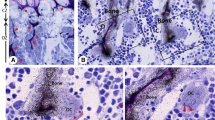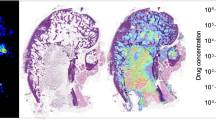Summary
We measured the individual lengths of fluorescent labels on the three subdivisions of the endosteal envelope in iliac bone biopsy specimens produced by the administration of both oxytetracycline and demethylchlortetracycline. Fifty-one healthy subjects and 53 patients with postmenopausal osteoporosis were labeled in the stated order, and 8 osteopenic patients were labeled in the reverse order. Whatever the order of administration, the demethylchlortetracycline label was longer than the oxytetracycline label. We conclude: (1) the difference in label lengths reflects a difference between the two compounds in some intrinsic property, whether physical, chemical, or pharmacokinetic. (2) If the calculation of extent of mineralizing surface is based on the mean length of the two labels, a suitable correction should be applied to the shorter label; alternatively, the length of the longer label alone should be used. (3) Unlabeled osteoid not due to label escape probably results from slow terminal mineralization after cessation of matrix synthesis during which too few tetracycline molecules are incorporated to exceed the threshold for visible fluorescence, rather than from the temporary interruption of mineralization followed by its resumption.
Similar content being viewed by others
References
Frost HM (1969) Tetracycline-based histological analysis of bone remodeling. Calcif Tiss Res 3:211–237
Parfitt AM, Drezner MK, Glorieux FH, Kanis JA, Malluche H, Meunier PJ, Ott SM, Recker RR (1987) Bone histomorphometry nomenclature, symbols and units. Report of the ASBMR Histomorphometry Nomenclature Committee. J Bone Miner Res 2:595–610
Parfitt AM, Rao DS, Stanciu J, Villanueva AR, Kleerekoper M, Frame B (1985) Irreversible bone loss in osteomalacia: comparison of radial photon absorptionmetry with iliac bone histomorphometry during treatment. J Clin Invest 76:2403–2412
Kleerekoper M, Peterson E, Phillips E, Nelson D, Tilley B, Parfitt AM (1989) Continuous sodium fluoride therapy does not reduce vertebral fracture rate in postmenopausal osteoporosis. J Bone Miner Res 4 [Suppl 1]:S376
Rao DS (1983) Practical approach to bone biopsy. In: Recker RR (ed) Bone histomorphometry: techniques and interpretation. CRC Press, Boca Raton, pp 4–11
Mathews CHE, Mehr L (1979) Staining and processing bone specimens for simultaneous tetracycline-osteoid seam assessment and histomorphometric quantitative analysis. J Histotechnol 2:23–24
Parfitt AM, Podenphant J, Villanueva AR, Frame B (1985) Metabolic bone disease with and without osteomalacia after intestinal bypass surgery: a bone histomorphometric study. Bone 6:211–220
Birkenhäger-Frenkel DH, Birkenhäger JC (1987) Bone appositional rate and percentage of doubly and singly labeled surfaces: comparison of data from 5 and 20 μm sections. Bone 8:7–12
Frost HM, Villanueva AR, Roth H, Stanisavljevic S (1961) Tetracycline bone labeling. J New Drugs 1:206–216
Parfitt AM (1989) Surface specific bone remodeling in health and disease. In: Kleerekoper M, Krane S (eds) Clinical disorders of bone and mineral metabolism. Mary Ann Libert Publishers, New York, pp 7–14
Colton T (1974) Statistics in medicine. Little Brown, Boston
Frost HM (1983) Bone histomorphometry: correction of the labeling “escape error”. In: Recker RR (ed) Bone histomorphometry: techniques and interpretation. CRC Press, Boca Raton, Florida, pp 133–142
Parfitt AM (1990) Bone forming cells in clinical disorders. In: Hall BK (ed) Bone: a treatise, vol 1, The osteoblast and osteocyte. Telford Press, (in press)
Kunin CM, Finland M (1961) Clinical Pharmacology of the tetracycline antibiotics. Clin Pharmacol Ther 2:51–69
Parfitt AM (1983) The physiologic and clinical significance of bone histomorphometric data. In: Recker R (ed) Bone histomorphometry: techniques and interpretation. CRC Press, Boca Raton, pp 143–223
Parfitt AM, Mathews C, Rao D, Frame B, Kleerekoper M, Villanueva AR (1981) Impaired osteoblast function in metabolic bone disease. In: DeLuca HF, Frost H, Jee W, Johnston C, Parfitt AM (eds) Osteoporosis: recent advances in pathogenesis and treatment. University Park Press, Baltimore, pp 321–330
Parfitt AM, Kleerekoper M, Villanueva AR (1987) Increased bone age: mechanisms and consequences. In: Christiansen C, Johnsen C, Riis BJ (eds) Osteoporosis 1987. Osteopress Aps, Copenhagen, pp 301–308
Martin RB (1989) Label escape theory revisited: the effects of resting periods and section thickness. Bone 10:255–264
Hori M, Takahashi H, Konno T, Inque J, Haba T (1985) A classification of in vivo bone labels after double labeling in canine bones. Bone 6:147–154
Ott SM (1989) Bone formation fails to show “on-off” pattern in postmenopausal osteoporosis. J Bone Miner Res 4 [Suppl 1]: S415
Hattner RS, Ilnicki LP, Hodge HC (1977) The dose-response relationship of tetracycline to the detectability of labeled osteons by fluorescence microscopy. In: Norman AW, Schaefer K, Coburn JW, DeLuca HF, Fraser D, Grigoleit HG, Herrath DV (eds) Vitamin D, biochemical, chemical and clinical aspects related to calcium metabolism, de Gruyter, New York, pp 377–380
Eriksen EF, Gundersen HJG, Melsen F, Mosekilde L (1984) Reconstruction of the formative site in iliac trabecular bone in 20 normal individuals employing a kinetic model for matrix and mineral apposition. Metab Bone Dis Rel Res 5:243–252
Author information
Authors and Affiliations
Rights and permissions
About this article
Cite this article
Parfitt, A.M., Foldes, J., Villanueva, A.R. et al. Difference in label length between demethylchlortetracycline and oxytetracycline: Implications for the interpretation of bone histomorphometric data. Calcif Tissue Int 48, 74–77 (1991). https://doi.org/10.1007/BF02555869
Received:
Issue Date:
DOI: https://doi.org/10.1007/BF02555869




